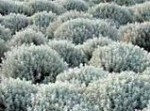 You might never dye your own cloth but having an herb garden that features plants historically used in dye making is an interesting and enjoyable endeavor. The colors are usually soft and include yellows, gold, oranges, reds, blues, greens, tans, browns and grays. Leaves, flowers, and roots are used in making dyes and the colors are dependent not only the plant part but also on the mordant used to fix the color and the type of fabric being dyed. Plants used for dyes can be beautiful additions to an herb garden and can be used to create a dye garden as a separate entity within the garden.
You might never dye your own cloth but having an herb garden that features plants historically used in dye making is an interesting and enjoyable endeavor. The colors are usually soft and include yellows, gold, oranges, reds, blues, greens, tans, browns and grays. Leaves, flowers, and roots are used in making dyes and the colors are dependent not only the plant part but also on the mordant used to fix the color and the type of fabric being dyed. Plants used for dyes can be beautiful additions to an herb garden and can be used to create a dye garden as a separate entity within the garden.
Here are five shrubs that are useful in dye making and can be an attractive addition to any garden. Information on the plant’s use in dying is given in regard to wool, the fiber most commonly dyed with natural fibers today.
 Barbary (Berberis vulgare)
Barbary (Berberis vulgare)
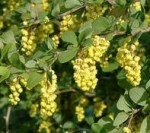 This easy to grow shrub thrives in fertile, moist, well-drained soil in full sun but tolerates some shade. It is hardy to zone 4 and is commonly grown as a hedge or barrier. If plants get too tall or overgrown they can be rejuvenated by cutting them back to a foot from the ground in late winter. Fertilize and water them well especially during the heat of summer and they will return with fresh new growth.
This easy to grow shrub thrives in fertile, moist, well-drained soil in full sun but tolerates some shade. It is hardy to zone 4 and is commonly grown as a hedge or barrier. If plants get too tall or overgrown they can be rejuvenated by cutting them back to a foot from the ground in late winter. Fertilize and water them well especially during the heat of summer and they will return with fresh new growth.
| Color | Plant Part | Mordant |
|---|---|---|
| Yellow | inner bark (fresh or dried) | none |
| Yellow | roots and bark (fresh or dried) | Tin |
| Tan | all (fresh or dried) | Alum |
| Dark Green | all (fresh or dried) | Iron |
 Broom (Cytisus scoparius)
Broom (Cytisus scoparius)
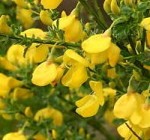 Give broom some sun and lean, well-drained soil and it will form a tall upright shrub that is covered with two-lipped yellow flowers in spring. Hardy in zones 6-8, broom has virtually no pest or disease problems and is easy to propagate by cuttings.
Give broom some sun and lean, well-drained soil and it will form a tall upright shrub that is covered with two-lipped yellow flowers in spring. Hardy in zones 6-8, broom has virtually no pest or disease problems and is easy to propagate by cuttings.
| Color | Plant Part | Mordant |
|---|---|---|
| Green-yellow | Tops (fresh) | Alum |
| Bright yellow | Flowers (fresh) | Alum |
| Deep yellow | Flowers (fresh) | Chrome |
 Lavender Cotton (Santolina chamaecyparissus)
Lavender Cotton (Santolina chamaecyparissus)
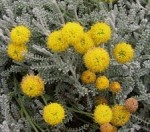 The gray color and scent of its leaves combined with its low stature make lavender cotton a great choice for a low growing hedge. Elizabethan gardeners prized it for its use in their knot gardens. Bright yellow button like flowers appear in spring. Hardy in zones 6-8, lavender cotton likes lean, light, well-drained soil, and full sun.
The gray color and scent of its leaves combined with its low stature make lavender cotton a great choice for a low growing hedge. Elizabethan gardeners prized it for its use in their knot gardens. Bright yellow button like flowers appear in spring. Hardy in zones 6-8, lavender cotton likes lean, light, well-drained soil, and full sun.
| Color | Plant Part | Mordant |
|---|---|---|
| Yellow | Leaves and flowers (fresh) | Alum |
| Gold | Leaves and flowers (fresh)/td> | Chrome |
 Oregon Grape (Mahonia aquifolium)
Oregon Grape (Mahonia aquifolium)
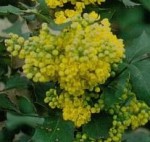 Tall evergreen bushes of shiny holly-like leaves are adorned with yellow flowers in spring, followed by purple berries. Oregon grape likes well-drained, humus rich soil, and shade, and grows well in zones 6 to 8.
Tall evergreen bushes of shiny holly-like leaves are adorned with yellow flowers in spring, followed by purple berries. Oregon grape likes well-drained, humus rich soil, and shade, and grows well in zones 6 to 8.
| Color | Plant Part | Mordant |
|---|---|---|
| Purplish-blue | fruit (fresh) | Alum |
| Khaki | yellow all (fresh) | Alum |
| Tan | roots (fresh) | Chrome |
 Potentilla (Potentilla verna)
Potentilla (Potentilla verna)
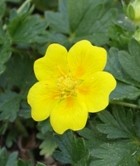 The dark green, strawberry-like foliage and 3-6” height make this potentilla a good ground cover or edging. Plants spread rapidly by forming a dense mat that can be mowed. It thrives in average, well-drained soil in zones 4-8, in sun or part shade. The bright yellow flowers appear in spring to early summer and last for a long time.
The dark green, strawberry-like foliage and 3-6” height make this potentilla a good ground cover or edging. Plants spread rapidly by forming a dense mat that can be mowed. It thrives in average, well-drained soil in zones 4-8, in sun or part shade. The bright yellow flowers appear in spring to early summer and last for a long time.
| Color | Plant Part | Mordant |
|---|---|---|
| Brown-red | roots (fresh) | Chrome |
| Purple-red | roots (fresh) | Iron |
All of these shrubs are easy to care for as well as being attractive so make good additions to any garden but especially to an herb garden. Using them to dye fabric is not easy; it is labor intensive, involves a lot of planning, and is time consuming. The rewards are great, however, and enjoyed by many gardeners.
